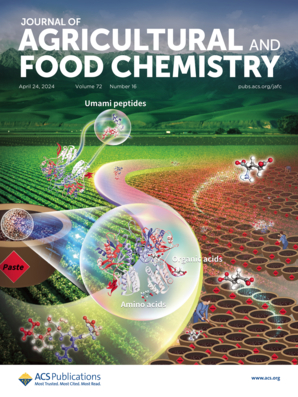凡纳滨对虾虾壳中的血蓝蛋白和β-1,3-葡聚糖结合蛋白是虾壳在热加工过程中由棕变红的原因。
IF 6.2
1区 农林科学
Q1 AGRICULTURE, MULTIDISCIPLINARY
引用次数: 0
摘要
由于甲壳类贝壳的成分和结构复杂,其在热加工过程中的颜色变化机制仍不清楚。本研究采用离子交换色谱法、凝胶过滤法和质谱法,从凡纳滨对虾虾壳中鉴定和表征了两种固有蛋白质成分,即血色素(Lv-Hc)和β-1,3-葡聚糖结合蛋白(Lv-BGBP)。研究发现,Lv-Hc(一种灰色蛋白质)和 Lv-BGBP(一种红色的天然虾青素结合蛋白)的混合物是鲜虾壳呈现棕色的原因。加热到 100 °C 时,这些蛋白质的混合物变成红色,模仿了在煮熟的虾壳中观察到的颜色变化。这种转变归因于 Lv-BGBP 极高的热稳定性,它能够保护虾青素不受热降解的影响。这些发现为我们深入了解虾壳着色的分子机制提供了重要线索,从而加深了我们对甲壳类生物化学的理解。本文章由计算机程序翻译,如有差异,请以英文原文为准。
Both Hemocyanin and β-1,3-Glucan-Binding Protein from the Shrimp Shell of Litopenaeus vannamei Are Responsible for Its Color Change from Brown to Red during Thermal Processing.
Because of the composition and structural complexity of crustacean shells, their color change mechanism during thermal processing remains unclear. This study identified and characterized two intrinsic protein components, hemocyanin (Lv-Hc) and β-1,3-glucan-binding protein (Lv-BGBP) from Litopenaeus vannamei shrimp shells by a combination of ion-exchange chromatography, gel filtration, and mass spectrometry. It was found that a mixture of Lv-Hc, a gray protein, and Lv-BGBP (which is a natural astaxanthin-binding protein with a red color) is responsible for the brown color of fresh shrimp shells. Upon heating to 100 °C, the mixture of these proteins turned red, mimicking the color change observed in cooked shrimp shells. This transition is attributed to the extremely high thermal stability of Lv-BGBP, which has the ability to protect astaxanthin from thermal induced degradation. These findings provide significant insights into the molecular mechanism governing shrimp shell coloration, advancing our understanding of crustacean biochemistry.
求助全文
通过发布文献求助,成功后即可免费获取论文全文。
去求助
来源期刊
CiteScore
9.90
自引率
8.20%
发文量
1375
审稿时长
2.3 months
期刊介绍:
The Journal of Agricultural and Food Chemistry publishes high-quality, cutting edge original research representing complete studies and research advances dealing with the chemistry and biochemistry of agriculture and food. The Journal also encourages papers with chemistry and/or biochemistry as a major component combined with biological/sensory/nutritional/toxicological evaluation related to agriculture and/or food.

 求助内容:
求助内容: 应助结果提醒方式:
应助结果提醒方式:


